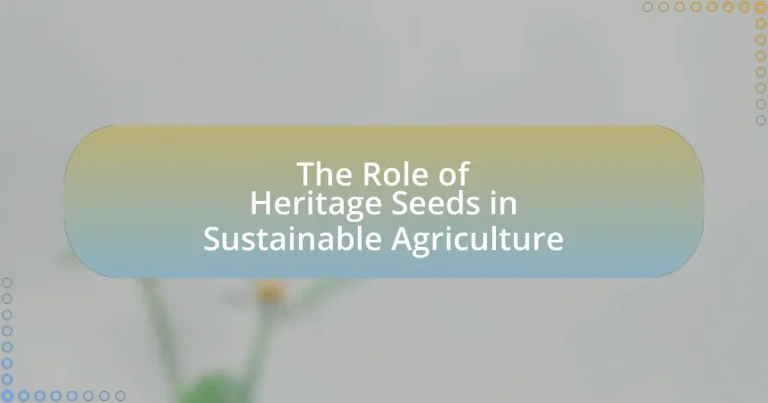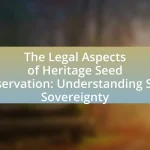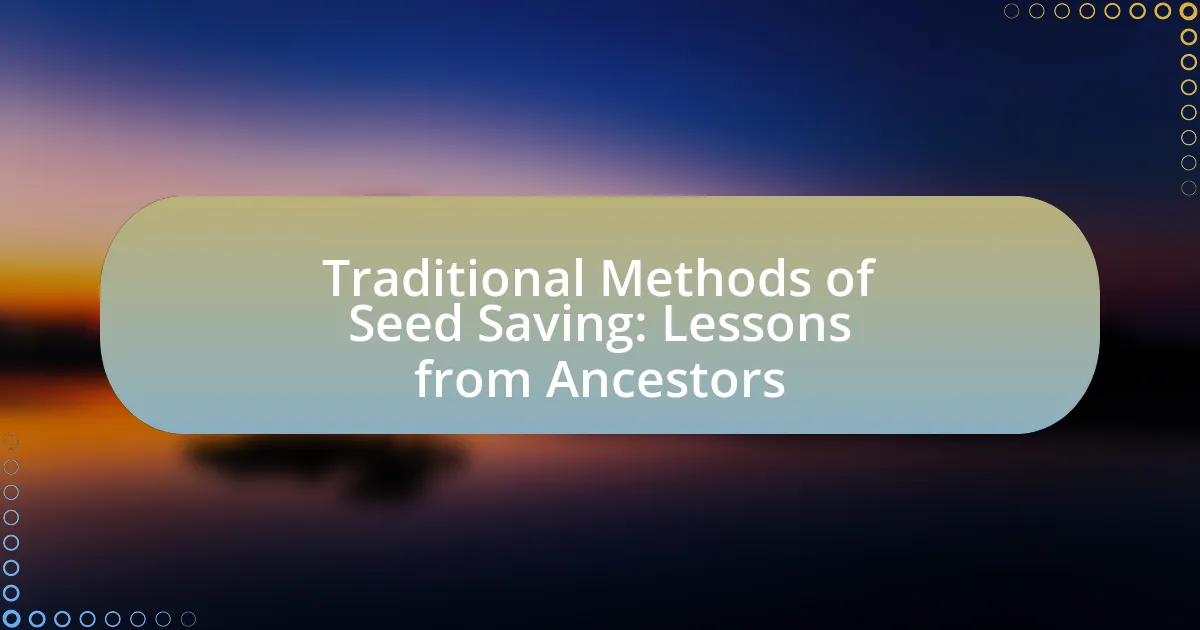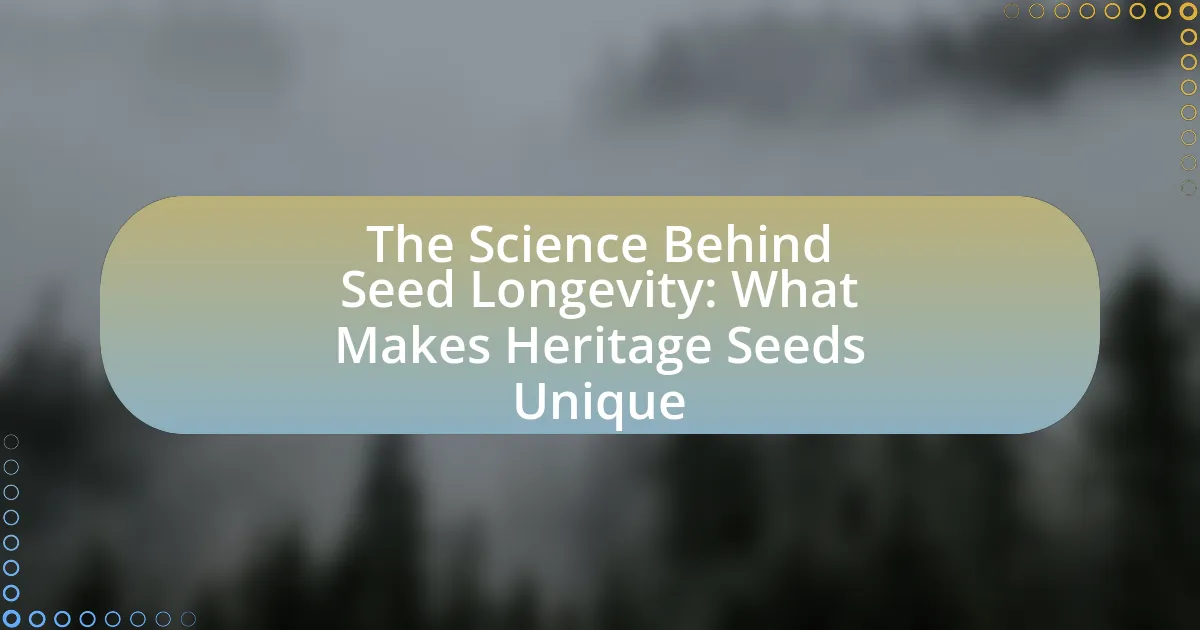Heritage seeds are traditional, open-pollinated seed varieties that have been cultivated over generations, known for their adaptability, resilience, and genetic diversity. They play a crucial role in sustainable agriculture by promoting biodiversity, enhancing food security, and supporting local ecosystems. The article explores the differences between heritage seeds and hybrid or GMO seeds, highlighting their unique characteristics and resilience against environmental stresses. It also discusses the economic benefits for farmers, the significance of genetic diversity, and the challenges heritage seeds face in modern agriculture, including industrial farming practices and regulatory hurdles. Additionally, it outlines best practices for utilizing heritage seeds effectively, emphasizing their importance in fostering sustainable agricultural systems.
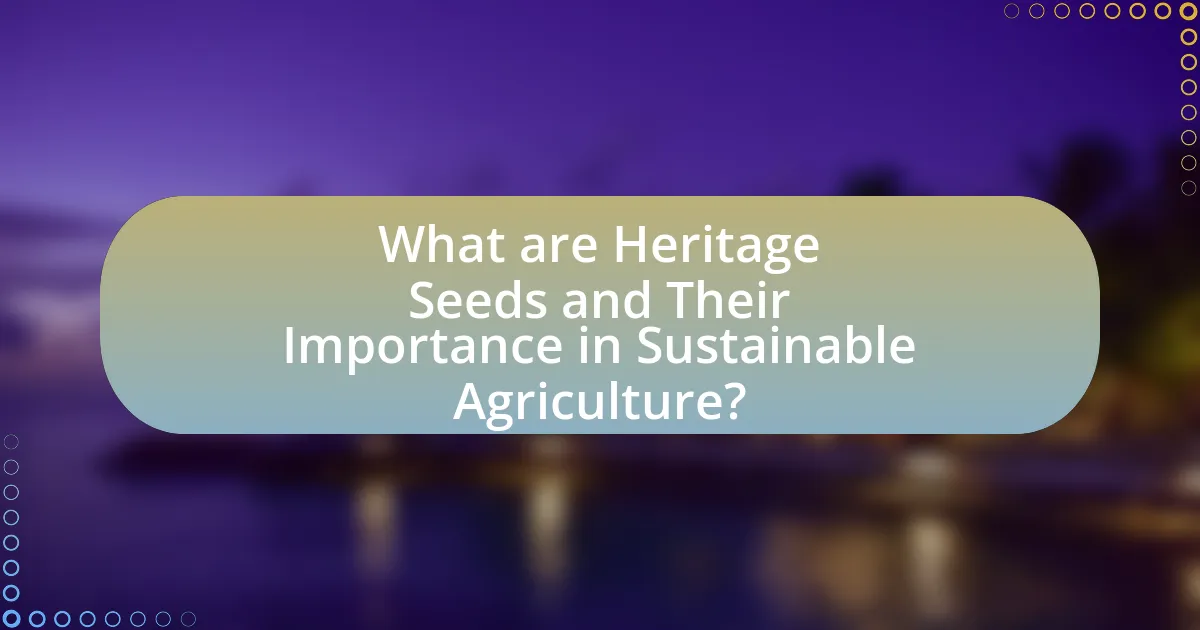
What are Heritage Seeds and Their Importance in Sustainable Agriculture?
Heritage seeds are traditional seed varieties that have been passed down through generations, often characterized by their adaptability, resilience, and genetic diversity. Their importance in sustainable agriculture lies in their ability to promote biodiversity, enhance food security, and support local ecosystems. Heritage seeds contribute to sustainable practices by allowing farmers to cultivate crops that are well-suited to their specific environments, reducing the need for chemical inputs and fostering soil health. Studies indicate that using heritage seeds can lead to increased crop resilience against pests and climate change, thereby supporting sustainable farming systems.
How do Heritage Seeds differ from Hybrid and GMO Seeds?
Heritage seeds differ from hybrid and GMO seeds primarily in their breeding methods and genetic stability. Heritage seeds are open-pollinated varieties that have been passed down through generations, maintaining their genetic traits and adaptability over time. In contrast, hybrid seeds are created through controlled cross-pollination of different plant varieties, resulting in offspring that may not retain the same traits in subsequent generations. GMO seeds, or genetically modified organisms, involve direct manipulation of an organism’s DNA using biotechnology, introducing traits that do not occur naturally. This fundamental difference in breeding and genetic modification leads to heritage seeds being more resilient and better suited for sustainable agriculture, as they can be saved and replanted year after year without loss of quality, unlike hybrids and GMOs which often require purchasing new seeds each season.
What characteristics define Heritage Seeds?
Heritage seeds are defined by their open-pollinated nature, genetic diversity, and historical significance. These seeds are typically non-hybrid varieties that have been passed down through generations, allowing them to adapt to local growing conditions and maintain unique traits. Heritage seeds often exhibit resilience to pests and diseases, contributing to sustainable agriculture practices. Additionally, they are valued for their flavor, nutritional quality, and ability to preserve biodiversity, as they represent a wide range of plant varieties that are crucial for ecological balance and food security.
Why are Heritage Seeds considered more resilient?
Heritage seeds are considered more resilient because they have been naturally selected over generations for their adaptability to local climates and conditions. This adaptability allows them to thrive in diverse environments, making them less susceptible to diseases and pests compared to modern hybrid varieties. Studies have shown that heritage seeds often possess a wider genetic diversity, which enhances their ability to withstand environmental stresses such as drought or extreme temperatures. For example, research conducted by the Seed Savers Exchange highlights that heritage varieties can maintain productivity under adverse conditions, demonstrating their robustness and reliability in sustainable agriculture.
What role do Heritage Seeds play in biodiversity?
Heritage seeds play a crucial role in biodiversity by preserving genetic diversity within plant species. These seeds, often heirloom varieties, maintain traits that are adapted to local environments, which enhances ecosystem resilience. For example, heritage seeds can contribute to the survival of various plant species by providing a genetic reservoir that can withstand diseases, pests, and climate change. Studies have shown that maintaining diverse seed varieties can lead to improved crop yields and sustainability, as evidenced by the work of the Seed Savers Exchange, which has documented over 25,000 varieties of heritage seeds, highlighting their importance in agricultural biodiversity.
How do Heritage Seeds contribute to ecosystem health?
Heritage seeds contribute to ecosystem health by promoting biodiversity and resilience in agricultural systems. These seeds are often open-pollinated and adapted to local conditions, which enhances genetic diversity among crops. Increased genetic diversity allows ecosystems to better withstand pests, diseases, and climate variability, reducing the need for chemical inputs. Research indicates that diverse plant populations can improve soil health and support beneficial organisms, such as pollinators and soil microbes, which are essential for a balanced ecosystem. For instance, a study published in the journal “Agriculture, Ecosystems & Environment” found that diverse cropping systems using heritage seeds led to improved soil structure and nutrient cycling, demonstrating their positive impact on ecosystem health.
What is the significance of genetic diversity in agriculture?
Genetic diversity in agriculture is crucial for enhancing resilience and adaptability of crops to changing environmental conditions. This diversity allows for a wider range of traits, such as disease resistance and drought tolerance, which are essential for food security. For instance, studies show that diverse crop varieties can yield better under stress conditions compared to monocultures, as they can share beneficial traits and improve overall ecosystem stability. Furthermore, genetic diversity supports sustainable practices by enabling farmers to select varieties that are best suited to their local conditions, thus reducing reliance on chemical inputs and promoting biodiversity.
How do Heritage Seeds support local farming communities?
Heritage seeds support local farming communities by promoting biodiversity and preserving traditional agricultural practices. These seeds are often adapted to local climates and soils, which enhances resilience against pests and diseases, thereby reducing the need for chemical inputs. According to a study by the Food and Agriculture Organization, maintaining genetic diversity through heritage seeds can lead to improved crop yields and food security, particularly in smallholder farming systems. Additionally, heritage seeds empower farmers by allowing them to save and exchange seeds, fostering community ties and reducing dependency on commercial seed companies.
What economic benefits do Heritage Seeds provide to farmers?
Heritage seeds provide significant economic benefits to farmers by enhancing crop resilience and reducing input costs. These seeds are often adapted to local growing conditions, which can lead to higher yields and lower reliance on chemical fertilizers and pesticides. For instance, a study by the University of California found that farmers using heritage varieties reported a 20% increase in yield compared to conventional seeds, primarily due to better adaptation to local climates. Additionally, heritage seeds can be saved and replanted, reducing the need for farmers to purchase new seeds each season, which can save them hundreds of dollars annually. This practice not only lowers costs but also promotes biodiversity and sustainability in agriculture.
How do Heritage Seeds promote food sovereignty?
Heritage seeds promote food sovereignty by preserving genetic diversity and enabling local communities to cultivate crops that are well-suited to their specific environments. These seeds are often open-pollinated and can be saved and replanted by farmers, which empowers them to maintain control over their food sources. Research indicates that heritage seeds contribute to sustainable agricultural practices by fostering resilience against pests and climate change, as diverse crops can better withstand environmental stresses. For example, a study by the Food and Agriculture Organization highlights that maintaining a variety of heritage seeds can enhance food security and reduce dependency on commercial seed markets, thus reinforcing local food systems and sovereignty.
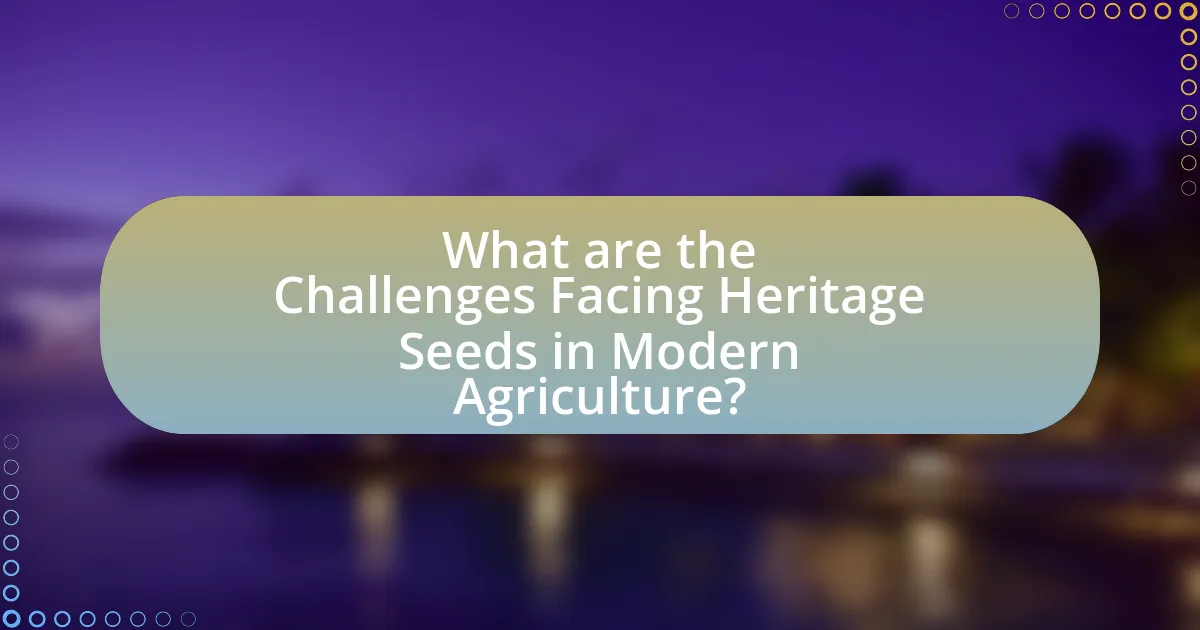
What are the Challenges Facing Heritage Seeds in Modern Agriculture?
Heritage seeds face several challenges in modern agriculture, primarily due to industrial farming practices, loss of biodiversity, and regulatory hurdles. Industrial agriculture often prioritizes high-yield, genetically modified crops, which diminishes the market for heritage seeds that may not produce as much but offer greater genetic diversity and resilience. The loss of biodiversity is exacerbated by monoculture practices, which threaten the survival of heritage varieties that are less commercially viable. Additionally, regulatory frameworks often favor patented seeds, making it difficult for farmers to access and cultivate heritage seeds without facing legal restrictions. These factors collectively hinder the preservation and use of heritage seeds in sustainable agricultural practices.
What threats do Heritage Seeds face from industrial agriculture?
Heritage seeds face significant threats from industrial agriculture primarily due to genetic homogenization and loss of biodiversity. Industrial agriculture often prioritizes high-yield, uniform crop varieties, which leads to the marginalization of heritage seeds that possess unique genetic traits. This practice reduces the genetic diversity essential for resilience against pests, diseases, and climate change, as evidenced by the fact that over 75% of crop diversity has been lost since the 1900s, according to the Food and Agriculture Organization. Additionally, the use of synthetic fertilizers and pesticides in industrial farming can negatively impact the soil health and ecosystem balance that heritage seeds thrive in, further endangering their viability.
How does the loss of traditional farming practices impact Heritage Seeds?
The loss of traditional farming practices negatively impacts Heritage Seeds by reducing genetic diversity and increasing the risk of extinction for these seeds. Traditional farming methods often involve the cultivation of a wide variety of local seed types, which helps maintain their unique traits and adaptability to local environments. As these practices decline, fewer farmers grow Heritage Seeds, leading to a decrease in their cultivation and preservation. According to a study by the Food and Agriculture Organization, approximately 75% of crop diversity has been lost over the last century due to industrial agriculture, which favors a limited number of high-yield varieties. This loss threatens the resilience of agricultural systems and diminishes the cultural heritage associated with these seeds.
What role does legislation play in the preservation of Heritage Seeds?
Legislation plays a crucial role in the preservation of Heritage Seeds by establishing legal frameworks that protect these seeds from genetic erosion and commercial exploitation. Specific laws, such as the Plant Variety Protection Act in the United States, provide legal recognition and protection for traditional varieties, ensuring that farmers can cultivate and share these seeds without fear of infringement. Additionally, international agreements like the International Treaty on Plant Genetic Resources for Food and Agriculture promote the conservation and sustainable use of Heritage Seeds, facilitating access to genetic resources while safeguarding farmers’ rights. These legislative measures are essential for maintaining biodiversity and supporting sustainable agricultural practices.
How can farmers overcome challenges related to Heritage Seeds?
Farmers can overcome challenges related to Heritage Seeds by implementing adaptive management practices and engaging in community seed-saving initiatives. Adaptive management allows farmers to experiment with different planting techniques and crop rotations that enhance the resilience of Heritage Seeds to local environmental conditions. Community seed-saving initiatives foster collaboration among farmers, enabling them to share knowledge, resources, and seeds, which helps maintain genetic diversity and improve seed quality. Research indicates that such collaborative efforts can lead to increased crop yields and sustainability, as demonstrated in studies by the Food and Agriculture Organization, which highlight the importance of local seed systems in enhancing food security.
What strategies can be implemented to promote Heritage Seed usage?
To promote Heritage Seed usage, strategies such as educational outreach, community seed banks, and partnerships with local farmers can be implemented. Educational outreach programs can inform farmers and consumers about the benefits of Heritage Seeds, including their adaptability and biodiversity, which are crucial for sustainable agriculture. Community seed banks can facilitate the sharing and preservation of Heritage Seeds, ensuring their availability and encouraging local cultivation. Additionally, partnerships with local farmers can create a network for sharing best practices and success stories, further enhancing the visibility and appeal of Heritage Seeds. These strategies are supported by research indicating that increased awareness and accessibility significantly boost the adoption of Heritage Seeds in agricultural practices.
How can community initiatives support Heritage Seed preservation?
Community initiatives can support Heritage Seed preservation by creating local seed banks that collect, store, and distribute these seeds to farmers and gardeners. These seed banks not only safeguard genetic diversity but also promote the cultivation of traditional varieties that are often more resilient to local environmental conditions. For example, the Seed Savers Exchange, a community-based organization, has successfully preserved thousands of heirloom seed varieties through member participation and education. This model demonstrates how community engagement can effectively maintain and enhance the availability of Heritage Seeds, ensuring their continued use in sustainable agriculture.

What are the Best Practices for Utilizing Heritage Seeds in Sustainable Agriculture?
The best practices for utilizing heritage seeds in sustainable agriculture include selecting locally adapted varieties, promoting biodiversity, and implementing organic farming techniques. Selecting heritage seeds that are well-suited to local climates and soils enhances resilience and productivity, as these varieties have evolved over time to thrive in specific conditions. Promoting biodiversity through the use of a diverse range of heritage seeds helps to maintain ecosystem balance and reduces vulnerability to pests and diseases. Implementing organic farming techniques, such as crop rotation and natural pest management, supports soil health and minimizes chemical inputs, aligning with sustainable agriculture principles. These practices are supported by research indicating that heritage seeds contribute to food security and environmental sustainability by preserving genetic diversity and fostering resilient agricultural systems.
How can farmers effectively cultivate Heritage Seeds?
Farmers can effectively cultivate Heritage Seeds by implementing traditional agricultural practices that promote biodiversity and soil health. These practices include selecting appropriate planting times based on local climate conditions, using organic fertilizers to enhance soil fertility, and employing crop rotation to prevent pest and disease buildup. Research indicates that Heritage Seeds often exhibit resilience to local pests and diseases, making them suitable for organic farming systems. Additionally, farmers should save seeds from their best-performing plants to maintain genetic diversity and adapt to changing environmental conditions, as evidenced by studies showing that seed saving can enhance crop yields over generations.
What are the best soil management practices for Heritage Seeds?
The best soil management practices for Heritage Seeds include maintaining soil health through organic matter addition, crop rotation, and minimal tillage. Organic matter, such as compost or cover crops, enhances soil structure and nutrient availability, which is crucial for the growth of Heritage Seeds. Crop rotation prevents soil nutrient depletion and reduces pest and disease cycles, promoting biodiversity. Minimal tillage preserves soil structure and microbial life, further supporting the sustainability of Heritage Seeds. Research indicates that these practices lead to improved soil fertility and resilience, essential for the successful cultivation of Heritage Seeds in sustainable agriculture.
How can crop rotation benefit Heritage Seed cultivation?
Crop rotation can significantly benefit Heritage Seed cultivation by enhancing soil health and biodiversity. By alternating different crops in a specific sequence, soil nutrients are replenished, reducing the need for chemical fertilizers. This practice also disrupts pest and disease cycles, which is crucial for maintaining the integrity of Heritage Seeds, known for their genetic diversity and resilience. Research indicates that crop rotation can increase yields by up to 20% while promoting sustainable farming practices, thus supporting the long-term viability of Heritage Seed varieties.
What resources are available for farmers interested in Heritage Seeds?
Farmers interested in Heritage Seeds can access a variety of resources, including seed banks, agricultural extension services, and online databases. Seed banks, such as the Seed Savers Exchange, provide a repository of heritage seeds and offer educational resources on their cultivation. Agricultural extension services often provide guidance on best practices for growing heritage varieties, including local workshops and publications. Online databases, like the USDA’s National Plant Germplasm System, offer searchable catalogs of heritage seeds, including information on their characteristics and growing conditions. These resources collectively support farmers in preserving biodiversity and promoting sustainable agricultural practices.
Where can farmers find Heritage Seed varieties?
Farmers can find Heritage Seed varieties at specialized seed companies, local seed exchanges, and agricultural fairs. These sources often focus on preserving traditional plant genetics and offer a range of heirloom seeds that are not commercially available. For instance, organizations like Seed Savers Exchange provide a platform for farmers to access a diverse selection of Heritage Seeds, promoting biodiversity and sustainable agriculture practices.
What organizations support Heritage Seed initiatives?
Organizations that support Heritage Seed initiatives include the Seed Savers Exchange, the Heritage Seed Library, and the Organic Seed Alliance. The Seed Savers Exchange focuses on preserving and sharing heirloom seeds, promoting biodiversity in agriculture. The Heritage Seed Library, part of the Garden Organic charity, aims to conserve traditional vegetable varieties and make them available to the public. The Organic Seed Alliance advocates for organic seed systems and supports the use of heritage seeds in sustainable farming practices. These organizations contribute to the preservation of genetic diversity and promote sustainable agricultural practices through their initiatives.
What practical tips can farmers follow to maximize the benefits of Heritage Seeds?
Farmers can maximize the benefits of Heritage Seeds by practicing crop rotation, selecting appropriate planting times, and maintaining soil health. Crop rotation helps prevent soil depletion and pest buildup, which is crucial for the sustainability of Heritage Seeds. For instance, rotating crops can enhance soil fertility and reduce the need for chemical fertilizers. Additionally, planting Heritage Seeds at optimal times ensures better germination and growth, as these seeds are often adapted to local climates. Maintaining soil health through organic amendments and cover cropping further supports the vitality of Heritage Seeds, leading to higher yields and resilience against diseases. Studies have shown that farms utilizing these practices can see improved biodiversity and ecosystem health, reinforcing the advantages of Heritage Seeds in sustainable agriculture.
